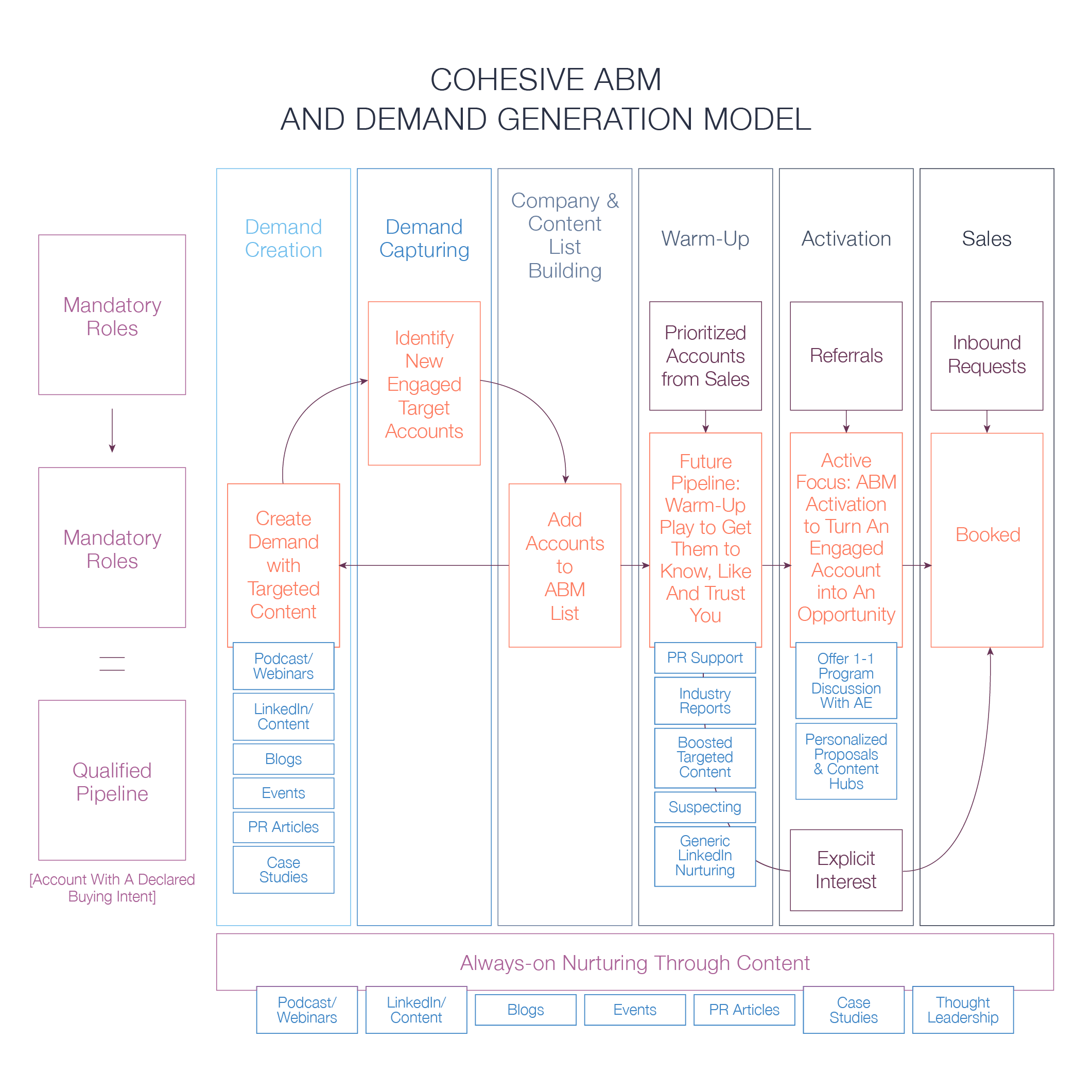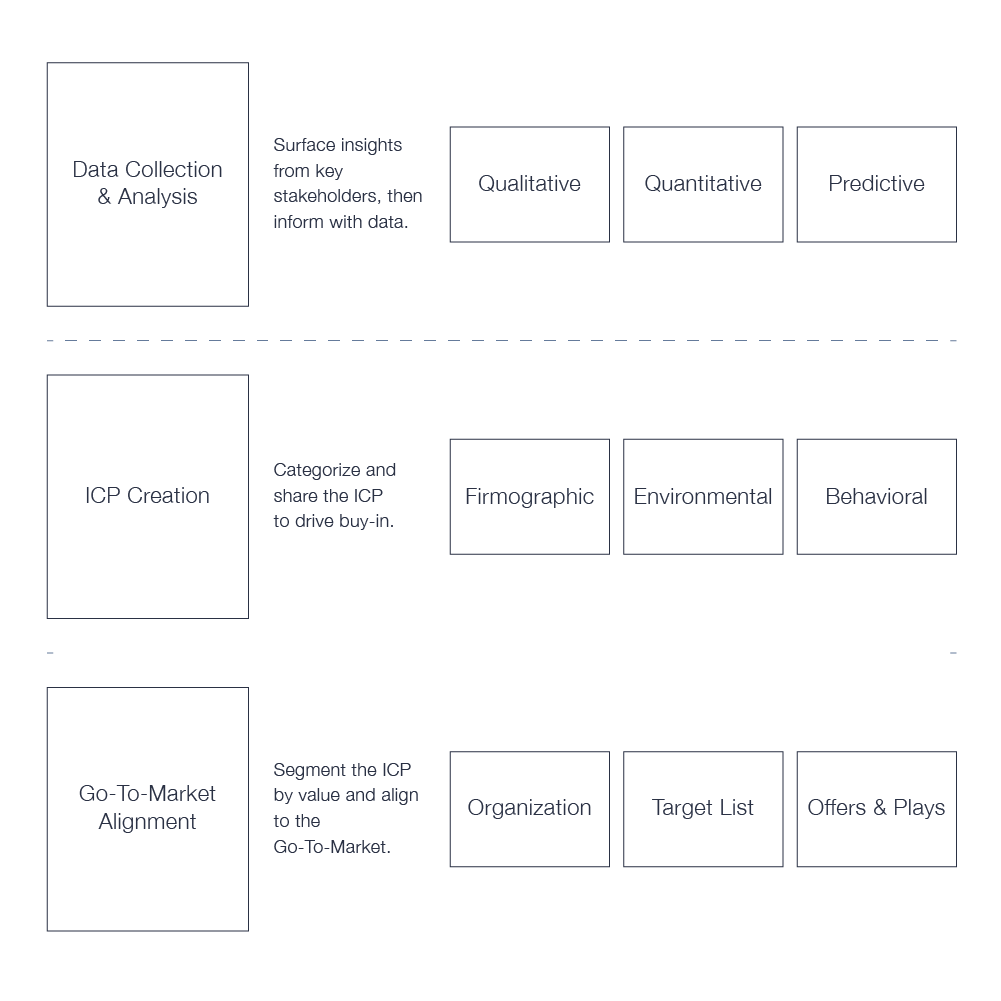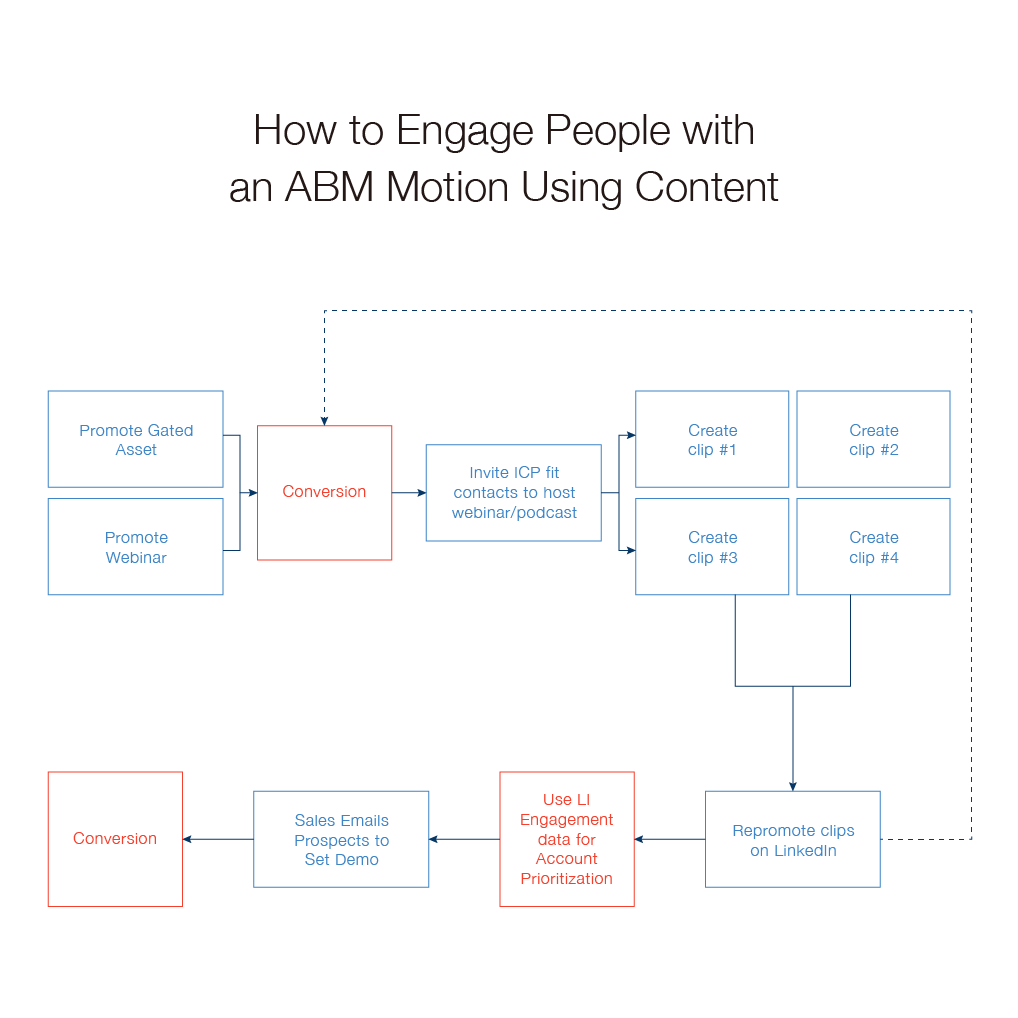Struggling to engage high-value accounts effectively?
Account based marketing strategies could be the solution. This article dives into how ABM can sharpen your focus, enhance personalized engagement, and drive significant revenue growth.
Learn the steps to create and implement successful account-based marketing campaigns.
Key Takeaways
-
Account-based marketing (ABM) focuses on high-value accounts, utilizing personalized strategies to enhance revenue acceleration and shorten sales cycles with enterprise accounts.
-
Implementing ABM strategies offers measurable ROI, with over 90% of organizations reporting improved financial returns compared to traditional marketing methods.
-
Successful ABM requires aligning sales and marketing teams, leveraging data and technology, and continuous monitoring and optimization across the customer journey.
Understanding Account Based Marketing

Account-based marketing (ABM) is a focused marketing strategy that targets high-value accounts for long-term revenue scalability.
Unlike traditional marketing approaches that cast a wide net to identify target accounts and attract as many leads as possible, ABM agencies dedicate resources to a select number of high-value accounts within a market. This targeted approach allows businesses to engage with key accounts using highly personalized account based marketing campaigns tailored to target account and their specific needs and challenges.
One of the key aspects of ABM is the use of personalized content to resonate with specific accounts. This can be achieved through various techniques, such as webinars and direct mail, which have regained popularity due to their effectiveness in engaging high-value accounts.
The ability to deliver targeted messages with precision has been greatly enhanced by new tools and technologies, enabling businesses to automate and optimize their ABM efforts.
Focusing on personal relationships with key stakeholders and addressing their unique pain points can speed up the sales process and improve close rates. This approach not only leads to higher revenues in a shorter timeframe but also enhances lead generation and drives long-term revenue growth.
With the increasing pressure on companies to impact revenue growth and engage with high-value accounts, ABM is becoming an essential component of B2B marketing strategies.
Key Benefits of Implementing ABM Strategies

Implementing an account-based marketing strategy offers numerous benefits, chief among them being a measurable return on investment (ROI).
Over 90% of organizations with advanced ABM practices report higher returns on investment compared to traditional marketing methods. In fact, 84% of businesses using ABM strategies report improved returns, making it a highly effective approach for driving revenue acceleration.
One of the standout benefits of ABM is its ability to shorten sales cycles by engaging all decision-makers from the outset. Nurturing all stakeholders simultaneously allows ABM initiatives to achieve a 30% reduction in sales cycle duration.
This is particularly beneficial for B2B companies where the buying process can be lengthy and complex. By focusing on high-value target accounts, ABM allows for a strategic allocation of resources, ensuring that marketing initiatives are concentrated where they can have the most impact.
In addition to financial benefits, ABM also helps in developing deeper, more significant relationships with customers. Demonstrating an understanding of customer needs and providing personalized solutions enhances experiences and fosters loyalty. This approach not only leads to higher quality leads but also ensures long-term customer retention and satisfaction.
With such compelling benefits, it’s no wonder that ABM strategies are gaining popularity among B2B marketers.
Steps to Develop an Effective ABM Strategy
Developing an effective ABM sales strategy often begins with thorough research to identify high-value opportunities. Identifying target accounts requires a deep dive into market studies and customer data to pinpoint accounts that align strategically with business goals. This involves analyzing revenue opportunity, industry fit, and other key metrics to ensure that the selected accounts are worth the investment.
Once the high-value quality accounts are identified, the next step is to select the right ABM approach based on organizational goals, resources, and the desired level of personalization. Building buyer personas by gathering insights about decision-makers’ roles, challenges, and preferences is crucial for crafting personalized marketing campaigns.
A clearly defined strategy, tailored to the specific needs of the specific companies, sets the foundation for successful ABM implementation.
Identifying High-Value Target Accounts
Identifying high-value good-fit accounts is a critical step in the ABM process. These accounts are defined as those with the potential for the highest revenue contribution.
Market studies and customer data should be meticulously analyzed to identify great-fit accounts that align strategically with business goals. Tools like visitor identifying tools and prospecting tools can enhance the identification process of key prospects by providing deeper insights into potential high-value target accounts.
Analyzing existing customers can also help identify ideal customer traits for high-quality accounts. Understanding the market position, strengths, weaknesses, and goals of the target account list of companies helps in prioritizing accounts based on criteria like revenue possibilities and fit with ideal customer profiles. This focused approach ensures that marketing initiatives are directed towards potential high value accounts that are most likely to yield significant returns.
Mapping Stakeholders to Accounts
Mapping stakeholders to accounts is essential for engaging key decision-makers and driving consensus for purchase decisions. This involves understanding the specific roles of stakeholders and aligning their needs with the overall business strategy. Key stakeholders to map within a company include roles such as CMO, digital marketing managers, CIO, and CFO.
Using automated lead scoring can facilitate the identification of these key decision-makers in target accounts. Direct engagement with these stakeholders is often necessary to address their concerns and needs effectively.
Resonating with the interests and challenges of each account and key stakeholder enhances strategic ABM campaigns and drives successful outcomes.
Crafting Personalized Campaigns
Crafting personalized campaigns is the cornerstone of any successful ABM strategy. This requires deep research into the target accounts’ specific concerns and pain points.
For each stakeholder influencing a buying decision, a unique value proposition and relevant content should be developed to address their individual needs. Utilizing a variety of content types, such as guides, whitepapers, and thought leadership articles, can effectively engage target accounts.
Tailoring experiences to each prospect is crucial for effective one-to-many ABM execution. This involves creating personalized messaging and marketing content that speaks directly to the challenges and goals of each account. By leveraging marketing automation tools, businesses can streamline content creation and automate personalization to enhance the overall impact of their ABM campaigns.
Best Practices for Successful ABM Implementation
As outlined in the video above, implementing ABM successfully requires adherence to best practices that ensure alignment between marketing and sales teams, effective use of data and technology, and continuous monitoring and optimization.
Aligning marketing and sales teams is crucial for the success of an ABM program, as it enables shared objectives and effective lead management. This alignment fosters collaboration and mutual understanding between teams, enhancing the overall effectiveness of ABM strategies.
Leveraging data and technology is another essential best practice for ABM implementation. Data analytics provides a better understanding of customers, enabling personalized engagement and improved tracking and measurement capabilities.
Continuous monitoring and optimization of ABM efforts ensure that strategies remain effective and adaptable to changing market dynamics. By following these best practices, businesses can maximize the impact of their ABM programs and achieve long-term success.
Aligning Sales and Marketing Teams
Aligning the sales rep and marketing teams is a fundamental step in ensuring the success of an ABM strategy. This alignment involves setting shared objectives and agreeing on common goals, messaging, content, execution, and success metrics. Collaborating throughout the buyer journey allows sales reps revenue teams to identify and nurture target accounts more effectively.
To further account engagement and enhance collaboration, it is essential to use tools that facilitate the sharing of account information between internal teams. Sales teams provide insights on top accounts and help develop effective personas for account team, which enhances the overall ABM strategy.
By aligning on target accounts and working towards shared goals, businesses can improve customer retention rates, align sales, and drive successful ABM outcomes.
Leveraging Data and Technology
Leveraging data and technology is crucial for the effective implementation of ABM strategies. AI technology can be used to analyze customer data, helping marketers identify key accounts and gain actionable insights. Data analytics provides a deeper understanding of customers, enabling personalized engagement and the creation of relevant content that resonates with target accounts.
Marketing automation tools are essential for streamlining content creation and automating personalization in ABM campaigns. These tools can also help track website visitors and personalize user experiences, enhancing overall engagement.
Cross-channel integration ensures a seamless experience across various platforms, further improving the effectiveness of ABM sales efforts everywhere. Focusing on actionable insights and avoiding vanity metrics helps sales teams drive more meaningful engagements with a high-value account.
Continuous Monitoring and Optimization
Continuous monitoring and optimization are essential components of a successful ABM strategy. Ongoing measurement focuses on moving accounts through the purchase process and gauging how quickly prospects move through the full sales funnel and pipeline. Key metrics to track include account churn rate, sales cycle length, and customer acquisition cost (CAC), which provide insights into process efficiency and spending effectiveness.
Utilizing tools like Google Analytics and other ABM platforms can help monitor performance and gain valuable insights. Researching specific concerns of target companies and accounts and applying insights from various ABM tools can help identify blind spots and areas for improvement.
An ABM framework often evolves over time, requiring regular reviews and adjustments to maintain its effectiveness. Continuously refining ABM tactics can lead to a 32% increase in post-click conversion rates, demonstrating the impact of continual optimization.
Types of Account Based Marketing Approaches

Account based advertising--based marketing can be categorized into three main approaches. Each approach varies in terms of the level of personalization and the number of accounts targeted, allowing businesses to choose the strategy that best aligns with their goals and resources using various account based advertising and marketing tactics.
One-to-one ABM focuses on unique content tailored to high-value good-fit accounts, requiring significant resources and attention. One-to-few ABM targets small groups of similar accounts, providing a balance between personalization and scalability.
One-to-many ABM leverages technology to deliver automated marketing messages to a larger audience, optimizing content for broad segments through data analytics. Understanding these approaches helps businesses implement the most effective ABM strategies for their specific needs.
One-to-One ABM
One-to-one ABM, also known as an strategic account based marketing strategy, involves highly personalized marketing objectives directed at individual high-value targets.
This approach requires a deep understanding of each account’s specific pain points and needs, allowing businesses to create customer-focused content such as white papers and case studies. Tailoring marketing messages to address unique challenges helps build strong relationships with key stakeholders and drives significant revenue growth.
However, one-to-one ABM demands a high amount of attention and resources, making it essential to narrow the prospect list to one to five accounts. This focused approach ensures that marketing initiatives are concentrated on accounts with the highest revenue potential, maximizing the impact of ABM campaigns.
One-to-Few ABM
One-to-few account based marketing strategy, also known as ABM lite, targets small groups of similar accounts, allowing businesses to create targeted campaigns for clusters of similar accounts. This approach provides a balance between personalization and scalability, enabling businesses to maintain a degree of personalization while reaching a larger audience.
In this form of ABM, similar marketing materials are used for all B2B prospects in the same cluster, allowing for efficient campaign execution. By focusing on groups of accounts with similar needs and characteristics, businesses can scale their marketing objectives while still delivering relevant and personalized content.
One-to-Many ABM
One-to-many ABM leverages technology to deliver automated marketing messages to a larger audience, optimizing content for broad segments through data analytics. This approach is ideal for businesses looking to reach a wide array of accounts with personalized messaging at scale.
By utilizing data analytics, businesses can tailor content to the specific needs and behaviors of a larger audience, enhancing engagement and driving conversions. One-to-many account based marketing enables businesses to efficiently manage large-scale marketing efforts while maintaining a level of personalization that resonates with their target audience of individual accounts.
Real-World Examples of ABM Success
Real-world account based marketing examples, of account based marketing examples success serve as powerful case studies, demonstrating the effectiveness of this targeted marketing strategy. Thomson Reuters, for instance, organized nearly 700 events to enhance brand trust and awareness among enterprise customers, achieving a 95% win rate through targeted engagements.
Similarly, GumGum’s personalized comic book campaign for T-Mobile successfully captured attention and led to a meeting with the CEO after it was shared on social media. VersionOne boosted engagement with 88% of their target accounts and increased opportunity value by 45% through their ABM strategy with Terminus.
Robin’s ABM strategy, showcasing existing office spaces, resulted in a 50% increase in website traffic and a 20% uptick in interest from decision-makers. These case studies exemplify the potential of ABM strategies for businesses looking to enhance their marketing effectiveness and return on investment inbound marketing efforts.
Overcoming Common ABM Challenges
Implementing ABM often comes with its own set of challenges, such as aligning teams and managing data effectively. Having too many technology tools can complicate data management, leading to silos and inefficiencies. To overcome these challenges, businesses need to streamline their tech stack and ensure seamless integration of data across platforms.
To align sales and marketing revenue teams is another common hurdle. By establishing shared objectives, utilizing collaboration tools, and fostering open communication, businesses can ensure that both teams work towards the common goal of successful ABM execution.
Addressing these challenges head-on can pave the way for successful account based marketing implementation and long-term account based marketing framework success.
Future Trends in Account Based Marketing

The future of ABM is poised to be shaped by advancements in AI-driven tools and the increasing focus on hyper-personalization. Leveraging AI and predictive analytics enhances campaign effectiveness and achieves stronger client engagement. Real-time intent data will become essential for capturing potential clients’ buying signals and tailoring responses accordingly.
As businesses continue to refine their ABM strategies, the integration of AI and advanced analytics will play a crucial role in driving targeted marketing efforts and achieving long-term revenue growth. Embracing these future trends will enable businesses to stay ahead of the curve and maximize the impact of their ABM campaigns.
Summary
In summary, Account-Based Marketing offers a powerful approach for targeting high-value targets and driving long-term revenue growth.
By focusing on personalized interactions and leveraging data and technology, businesses can enhance their marketing ROI and build deeper relationships with key accounts and increase customer lifetime value.
Successful ABM implementation requires alignment between marketing team and your sales team, continuous monitoring and optimization, and the adoption of best practices. As we look to the future, advancements in AI and hyper-personalization will further elevate the effectiveness of ABM strategies.
Embracing these account based marketing tactics, tools and trends to stay ahead in the competitive B2B landscape and achieve sustained marketing success.
Frequently Asked Questions
What is Account-Based Marketing (ABM)?
Account-Based Marketing (ABM) is a strategic approach that concentrates on high-value accounts using tailored campaigns to enhance revenue growth. This methodology ensures that marketing efforts are aligned with the specific needs of key clients.
What are benefits of implementing an account based marketing strategy?
Implementing account based marketing strategies provides higher ROI, shorter sales cycles, more strategic resource allocation, and fosters deeper customer relationships. These advantages can significantly enhance the effectiveness of your marketing objectives.
How do you identify high-value target accounts in ABM?
To identify any good-fit high-value target account in Account-Based Marketing (ABM), conduct thorough research and analysis of market studies, customer data, and assess revenue potential. This strategic approach enables focused targeting and maximizes return on investment.
What are the best practices for successful ABM implementation?
For successful an ABM program implementation, it is essential to align marketing and sales teams, utilize data and technology effectively, and engage in continuous monitoring and optimization of your marketing and sales efforts. These practices will enhance your ABM strategy's effectiveness.
What future trends will shape ABM strategies?
AI-driven tools, hyper-personalization, real-time intent data, and predictive analytics will significantly enhance targeting and engagement, shaping the future of ABM and other marketing strategies. These trends emphasize the need for more precise and individualized marketing efforts.


